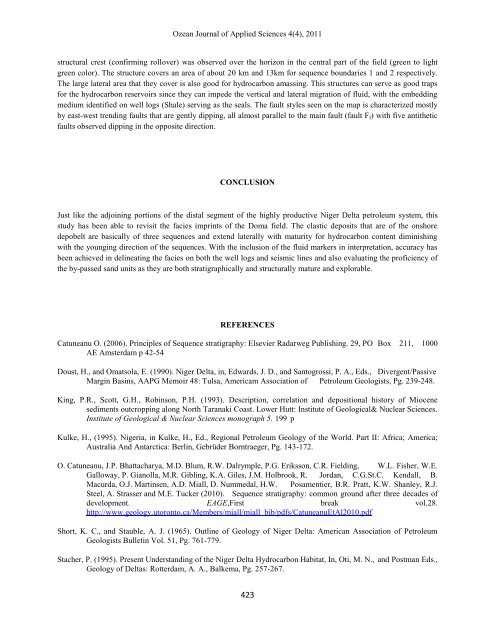download current issue - Ozean Publications
download current issue - Ozean Publications
download current issue - Ozean Publications
Create successful ePaper yourself
Turn your PDF publications into a flip-book with our unique Google optimized e-Paper software.
<strong>Ozean</strong> Journal of Applied Sciences 4(4), 2011<br />
structural crest (confirming rollover) was observed over the horizon in the central part of the field (green to light<br />
green color). The structure covers an area of about 20 km and 13km for sequence boundaries 1 and 2 respectively.<br />
The large lateral area that they cover is also good for hydrocarbon amassing. This structures can serve as good traps<br />
for the hydrocarbon reservoirs since they can impede the vertical and lateral migration of fluid, with the embedding<br />
medium identified on well logs (Shale) serving as the seals. The fault styles seen on the map is characterized mostly<br />
by east-west trending faults that are gently dipping, all almost parallel to the main fault (fault F f ) with five antithetic<br />
faults observed dipping in the opposite direction.<br />
CONCLUSION<br />
Just like the adjoining portions of the distal segment of the highly productive Niger Delta petroleum system, this<br />
study has been able to revisit the facies imprints of the Doma field. The clastic deposits that are of the onshore<br />
depobelt are basically of three sequences and extend laterally with maturity for hydrocarbon content diminishing<br />
with the younging direction of the sequences. With the inclusion of the fluid markers in interpretation, accuracy has<br />
been achieved in delineating the facies on both the well logs and seismic lines and also evaluating the proficiency of<br />
the by-passed sand units as they are both stratigraphically and structurally mature and explorable.<br />
REFERENCES<br />
Catuneanu O. (2006). Principles of Sequence stratigraphy: Elsevier Radarweg Publishing. 29, PO Box 211, 1000<br />
AE Amsterdam p 42-54<br />
Doust, H., and Omatsola, E. (1990). Niger Delta, in, Edwards, J. D., and Santogrossi, P. A., Eds., Divergent/Passive<br />
Margin Basins, AAPG Memoir 48: Tulsa, Americam Association of Petroleum Geologists, Pg. 239-248.<br />
King, P.R., Scott, G.H., Robinson, P.H. (1993). Description, correlation and depositional history of Miocene<br />
sediments outcropping along North Taranaki Coast. Lower Hutt: Institute of Geological& Nuclear Sciences.<br />
Institute of Geological & Nuclear Sciences monograph 5. 199 p<br />
Kulke, H., (1995). Nigeria, in Kulke, H., Ed., Regional Petroleum Geology of the World. Part II: Africa; America;<br />
Australia And Antarctica: Berlin, Gebrüder Borntraeger, Pg. 143-172.<br />
O. Catuneanu, J.P. Bhattacharya, M.D. Blum, R.W. Dalrymple, P.G. Eriksson, C.R. Fielding, W.L. Fisher, W.E.<br />
Galloway, P. Gianolla, M.R. Gibling, K.A. Giles, J.M. Holbrook, R. Jordan, C.G.St.C. Kendall, B.<br />
Macurda, O.J. Martinsen, A.D. Miall, D. Nummedal, H.W. Posamentier, B.R. Pratt, K.W. Shanley, R.J.<br />
Steel, A. Strasser and M.E. Tucker (2010). Sequence stratigraphy: common ground after three decades of<br />
development. EAGE,First break vol.28.<br />
http://www.geology.utoronto.ca/Members/miall/miall_bib/pdfs/CatuneanuEtAl2010.pdf<br />
Short, K. C., and Stauble, A. J. (1965). Outline of Geology of Niger Delta: American Association of Petroleum<br />
Geologists Bulletin Vol. 51, Pg. 761-779.<br />
Stacher, P. (1995). Present Understanding of the Niger Delta Hydrocarbon Habitat, In, Oti, M. N., and Postman Eds.,<br />
Geology of Deltas: Rotterdam, A. A., Balkema, Pg. 257-267.<br />
423

















